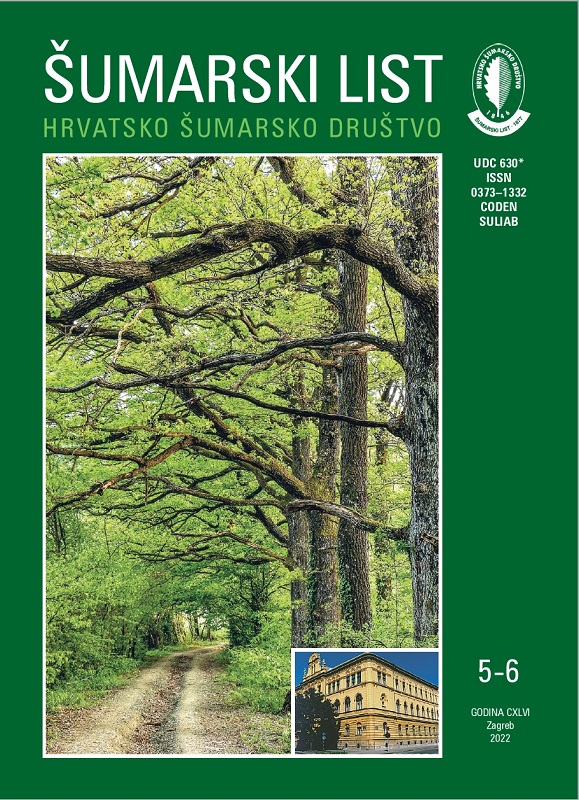
broj: 5-6/2022
pdf (11,37 MB) |
|
||||||||||||||
| RIJEČ UREDNIŠTVA | ||
| Uredništvo | ||
| XV World Forestry Congress pdf HR EN | 173 | |
| IZVORNI ZNANSTVENI ČLANCI | ||
| Krunoslav Sever, Davor Poljaković, Tomislav Karažija, Boris Lazarević, Antonia Vukmirović, Mario Šango, Željko Škvorc | UDK 630* 815 + 847 (001) https://doi.org/10.31298/sl.146.5-6.1 | |
| Growth of common beech (Fagus sylvatica L.) saplings under the impact of suboptimal mineral nutrition pdf HR EN | 175 | |
| Jelena Kolić, Renata Pernar, Ante Seletković, Mirna Samaržija, Mario Ančić | UDK 630* 533 + 535 (001) https://doi.org/10.31298/sl.146.5-6.2 | |
| Comparison of crown damage assessment on analog and digital infrared color (CIR) aerial photographs pdf HR EN | 187 | |
| Matija Landekić, Ivan Bošnjak, Matija Bakarić, Mario Šporčić | UDK 630* 309 (001) https://doi.org/10.31298/sl.146.5-6.3 | |
| Trends and relations of occupational safety indicators in Croatian forestry pdf HR EN | 201 | |
| Mirjana Šipek, Eva Horvat, Ivana Vitasović Kosić, Nina Šajna | UDK 630* 449 (001) https://doi.org/10.31298/sl.146.5-6.4 | |
| Presence of alien Prunus serotina and Impatiens parviflora in lowland forest fragments in NE Slovenia pdf HR EN | 215 | |
| Summary Temperate alluvial, riparian and lowland forests are the European forests with the greatest presence of invasive alien plants. Consequently, identifying the environmental conditions for and other drivers behind the establishment of invasive species in natural forest communities is crucial for understanding the invasibility of these habitats. We focused on fragments (patches) of Illyrian oak-hornbeam forest in NE Slovenia, which are the least studied in this regard. Because alien phanerophytes and therophytes are significantly over-represented compared to native plants in lowland forests, we selected two representative invasives: the phanerophyte Prunus serotina and the therophyte Impatiens parviflora. By using logistic regression models on vegetation surveys, environmental data based on Ellenberg´s indicator values, and patch metrics, we identified patch characteristics explaining the presence of each species. Moreover, we included human impact in the models. We reveal significant characteristics differentiating P. serotina from I. parviflora. We also show that the perimeter-area ratio and soil nutrients of the forest patches correlate significantly with the presence of P. serotina, while human disturbance correlates significantly with the presence of I. parviflora. Our results and a similar approach for other invasive plant species can be applied to assess habitat invasibility on potential and species’ current geographic distribution, as well as to develop management plans. Key words: biological invasions; forest fragmentation; landscape metrics; habitat characteristics; human presence; neophytes | ||
| PREGLEDNI ČLANCI | ||
| Ivana Gašparović, Željko Španjol, Boris Dorbić, Nikola Vrh, Ivan Tolić, Milan Vojinović, Sanja Stevanović | UDK 630* 272 https://doi.org/10.31298/sl.146.5-6.5 | |
| Landscape and ecological valorisation in the context of protection and revitalisation of Hober forest park in Korčula, the Republic of Croatia pdf HR EN | 225 | |
| STRUČNI ČLANCI | ||
| Vladimir Stojanović, Damir Demonja, Maja Mijatov, Jelena Dunjić, Sanja Tišma | UDK 630* 611 https://doi.org/10.31298/sl.146.5-6.6 | |
| Concept of ecotourism development in UNESCO biosphere reserves: Case studies from Croatia and Serbia pdf HR EN | 243 | |
| Irena Papazova-Anakieva, Sterja Načeski, Margarita Georgieva | UDK 630* 272 + 523 https://doi.org/10.31298/sl.146.5-6.7 | |
| The health condition of trees in dendropark at Faculty of Forestry – Skopje with a special focus on fungal diseases and insect pests pdf HR EN | 255 | |


